When is it better to plant raspberries in the middle zone - in spring or autumn?
Raspberries have rightfully become the favorite berry of many gardeners for their taste and ease of care. It is planted at different times of the year. Most people plant in spring, but autumn planting also has significant advantages. We will tell you in detail about the agricultural technology of raspberries in the country in the middle zone.
The best raspberry varieties for central Russia
The raspberry plant will produce a good harvest if it is given full care. But first of all, you need to decide on the appropriate variety of berries.
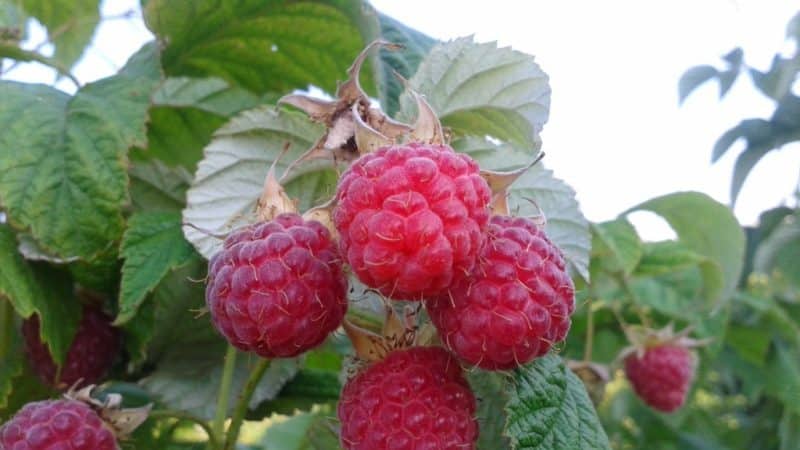
Arbat
The variety is highly resistant to fungal diseases and pests. The bush is spreading and tall - it grows up to 2 m in height. The berries are oblong, dense, weighing from 4 to 12 g. Up to 5 kg are harvested from the bush per season. It bears fruit annually in mid-summer. In the absence of proper care, the plant is damaged by raspberry beetles and spider mites.
Brigantine
The bushes are slightly spreading, the stems are erect, the thorns are sparse. The berries are oval-conical in shape, weighing 3-3.2 g. Productivity - 2.2-2.5 kg per bush. The variety is resistant to anthracnose and spider mites, but is susceptible to purple spot and mycoplasma. Tolerates frost and drought well.
Bryansk miracle
The berries are cone-shaped, weighing up to 11 g. The yield from one bush reaches 3 kg. Fruits from August to the second half of September. Disadvantages include low transportability of fruits and a large number of thorns on the shoots. It has good resistance to drought, frost and diseases, with the exception of fungal ones.
Glen Ample
The berries are round-conical, dense and juicy, weighing up to 5 g. Productivity - up to 2 kg per bush. It bears fruit during July; the absence of thorns makes harvesting easier. Not afraid of frost and drought. Resistant to fungal diseases, but with high humidity it can suffer from rust and powdery mildew.
Yellow giant
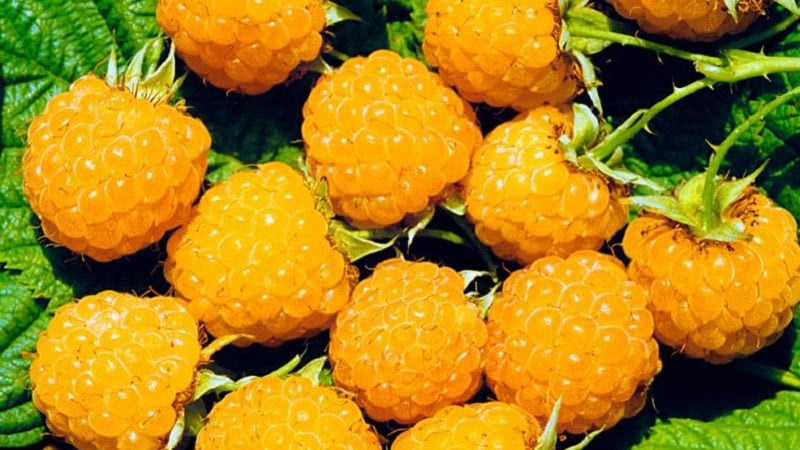
The berries are yellow in color with a slight honey taste, the weight of one fruit reaches 8 g. They do not fall off for a long time, but are poorly stored after picking. Up to 10 kg are collected from one bush. The variety bears fruit from early July to mid-August. It is highly resistant to diseases and pests, but can get sick due to too cold water and its excess, as well as pest larvae remaining in the ground from previously planted crops.
Crane
The berries are red in color, blunt-conical in shape, with a delicate sweet and sour taste and weighing 2 g. They have a wide range of applications: they are frozen, consumed fresh, and prepared in cocktails, desserts and jam. The variety bears fruit from mid-July until frost. Up to 3.5 kg is collected from one bush. The plant is resistant to frost and drought, but with excess humidity there is a risk of the spread of fungal diseases. The variety is susceptible to attack by spider mites, aphids, beetles and caterpillars.
Meteor
The berries are round-conical in shape, average weight is 2.5-3 g. Excellent for freezing and preparing. The raspberry tree produces a harvest of up to 2 kg per bush in early August. The variety is not afraid of frost, resistant to fungal diseases, but is vulnerable to shoot gall midge, spider mites, growth and purple spot.
Orange miracle
The berries, weighing up to 5 g, are bright yellow with a pinkish tint, have a rich taste with sourness, hold their shape and do not crumble for a long time.The yield reaches 3 kg per bush. The variety bears fruit in July and from late August until frost. Resistant to diseases and pests, but does not tolerate extreme cold and excessive drought.
Patricia
The berries are very large, weighing up to 14 g, and have a pleasant rich taste. Raspberries are distinguished by a long fruiting period - from June to September - and high yield - up to 8 kg per bush. Does not tolerate transportation well. Not afraid of drought and cold. The variety is resistant to viral diseases, but vulnerable to fungal diseases. It is attacked by spider mites, shoot gall midges and weevils.
This is interesting:
Which raspberry varieties are the most productive?
Agrotechnics of raspberries at the dacha in the middle zone
When planting seedlings, it is necessary to have complete information about the characteristics of growing the variety in the region and caring for the crop.

Planting seedlings
The method of planting raspberries depends on how many bushes you plan to place on your site. For small quantities, the pit method is better, and for large quantities, the trench method is better.
Hole planting method:
- The holes are made 25-30 cm in depth and width.
- Drainage is laid in the base with a layer of 3-4 cm.
- Nutrient soil is placed in each hole with a layer of 2-3 cm.
- Before planting, the holes are watered.
Trench planting method:
- The depth of each trench is 30 cm.
- Soil is laid at the bottom in a layer of 2-3 cm.
- The trench is watered with water - 2 liters per 1 sq. m.
To prevent the appearance of pests, low cutting and removal of fruit-bearing stems are used. Regularly thin out dense growth and trim shoots.
When is it better to plant raspberries - in spring or autumn?
Both spring and autumn planting are possible, but the latter is more preferable, since seedlings are much more comfortable at this time of year.
The most successful period is from mid-September to the end of October. The main advantage of planting at this time is that the seedlings will begin to grow as the weather warms up.
In spring, raspberries are planted when the ground has already warmed up sufficiently. This time usually occurs at the end of April. Melt water will provide the raspberries with the necessary substances, but high temperatures may prevent the plant from taking root in a new place.
Site selection and soil preparation
Areas with moist soil without stagnant water are allocated for planting raspberries. The southern part of the fence is suitable for this, if it is not shaded. Planting in highlands is undesirable - it is too dry there - and in lowlands, where the raspberries will begin to rot due to accumulated moisture.
Do not plant it in soil where potatoes, eggplants, strawberries and tomatoes previously grew. It is also best to avoid proximity to these crops. You cannot plant raspberries between fruit trees - the roots of the plants will interfere with each other. But in place of legumes, cereals, zucchini, cucumbers and onions and garlic, the berry will feel comfortable.
The soil needs a drainage layer that will prevent waterlogging. Clay soil is diluted with sand, peat and compost. Ash, chalk and dolomite flour are added to acidic soil.
When planting in autumn, the soil begins to be prepared a month in advance; when planting in spring, in the fall.
Attention! Before planting, do not forget to remove any remaining roots, debris, and add fertilizer from the ground.
Caring for raspberries in the middle zone
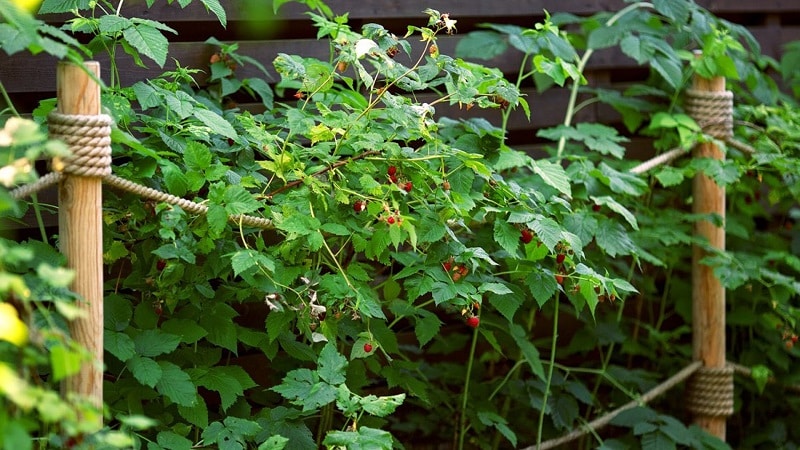
Caring for plants involves watering, fertilizing, loosening, preventive processing, garter, trimming and shelter for the winter.
Water the bushes based on the climate and current weather, since in the middle zone due to frequent rains, watering may not be required for weeks.
After watering, the soil is loosened shallowly; most often, the procedure is replaced by mulching. Moisture remains under the mulch layer for a short time and a crust does not form. Thanks to this, the plants do not rot and the weeds do not have time to germinate.
Since the bushes bend under the weight of the crop, they need to be tied up. The most popular method is to stretch wire along a row of plantings and tie shoots to it.
Watering and fertilizing
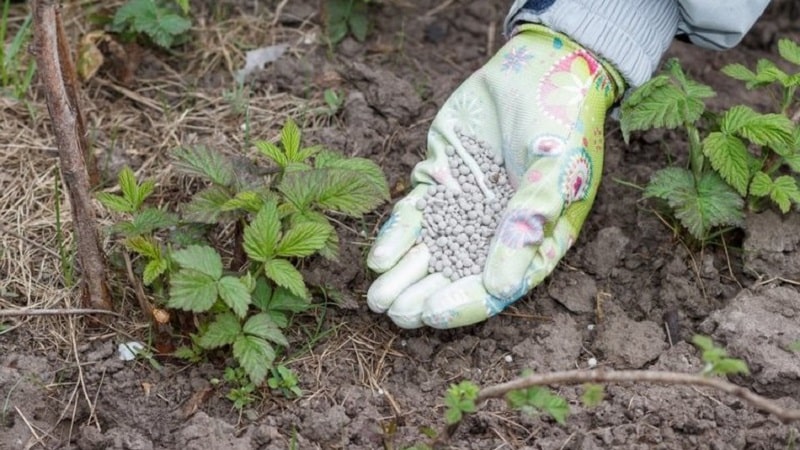
The bushes are watered at the root with rain or settled water. Drip or regular furrow irrigation is suitable for raspberries. It is important to monitor the condition of the soil, because raspberries do not tolerate both drought and waterlogging. At the beginning of autumn, watering is stopped - the plant will have enough natural precipitation.
Before the first feeding, a ditch is dug around the bush, where fertilizers are applied.
Reference. Raspberries respond well to organic and nitrogen feeding, as well as urea.
On average, during the year per 1 sq. m contribute:
- 5-6 kg of organic fertilizers - in autumn and spring in a 7 cm layer, covering with 2 cm of soil;
- 20 g of ammonium nitrate – 2/3 of the norm in spring and the remainder in summer;
- 30 g of superphosphate and 15 g of potassium salt - after harvesting.
Double pruning according to the Sobolev method
The author of this method is A. G. Sobolev. Pruning carried out twice. A simple method allows you to double your harvest without complex agricultural techniques.
It is recommended to use this method when planting new plantings or updating old ones. It is better to provide a large distance between the bushes. This will help avoid high planting densities and intertwining branches.
Timing of pruning

The first pruning is carried out at the end of May - beginning of June, no later than the 10th. Shoots with a height of 0.7-1 m are pruned. This results in abundant shoot formation and cessation of upward growth.
The second pruning is carried out the following year, in the spring, when the leaves bloom. The side shoots that have grown after the first pruning are pinched to 5-15 cm.
As a result of such procedures, the bush bears fruit longer, and ordinary raspberry varieties acquire the qualities of remontant ones.
Trimming scheme

Pruning is necessary for the normal development of the bush. Neglecting the procedure will lead to negative consequences: lack of nutrients, sunlight and the proliferation of pests.
Work order:
- For the first time, annual branches are pruned, reaching 1 m in medium-sized varieties and 60 cm in low-growing varieties.
- Together with the upper bud, an additional 10 cm is cut off.
- After the shoots get stronger and grow new branches up to 50 cm, remove all root shoots.
- Weak shoots are cut off.
- Next spring remove young branches and cut off the side branches by 10 cm. Together with the upper bud, 10-15 cm are removed.
- Since the bush grows strongly, it is tied to a trellis.
Preparing raspberries for winter
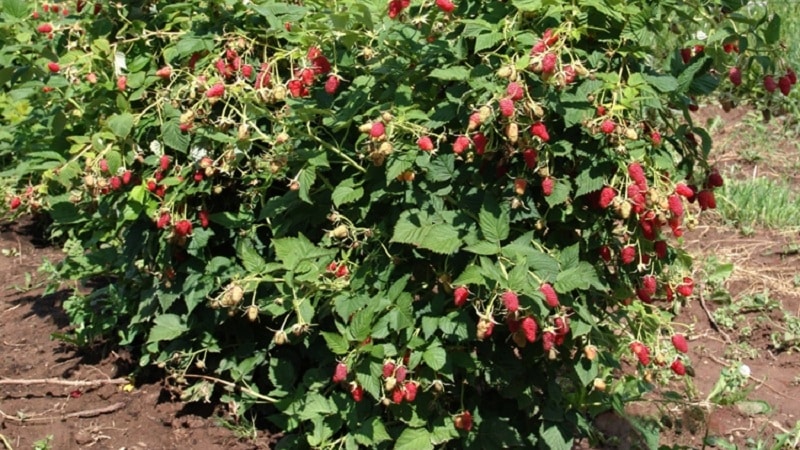
Although most raspberry varieties tolerate cold well, they still require some preparation:
- First of all, pay attention to pruning. Remove all diseased, damaged, crooked branches that create excess density. Young shoots are cut at the root, and the stems are left 1 m in height. The remaining leaves are removed.
- The soil is loosened and the final fertilizing is applied - potassium-phosphorus compounds or compost.
- In cold regions, mulching is necessary. It will protect the roots from frost.
- The branches are tied together and the bush is bent to the ground at a height of 30 cm. For additional protection, the raspberry tree is covered with agrofibre.
When remontant raspberries bear fruit in the middle zone

Remontant raspberries are capable of continuous fruiting throughout the season. The exact timing depends on the specific variety. After the first harvest, it blooms and bears fruit again, not only on annual shoots, but also on biennial shoots.
Also, remontant raspberries have high frost resistance and do not require careful care. The entire above-ground part is cut off for the winter, so there is no need to remove fruit-bearing stems and bend them to the ground. This leads to another advantage - pathogens and pests are thus removed.
To get a good harvest, choose illuminated places for planting. It is better to plant raspberries on the south side of buildings, and when digging, it is recommended to add humus and compost.
Important! For most varieties, with average soil fertility, the distance between rows is 1.5-2 m, between plants - 0.7-0.9 m. Bushes with this placement are much better illuminated.
Conclusion
Now you know about the best varieties of raspberries, the intricacies of growing and caring for them. It's the right time for planting - in September and October. To do this, choose a lighted place in the southern part of the fence. The plant is provided with drip watering, fed, pruned, tied and covered for the winter. Following agricultural practices will allow you to enjoy a rich harvest of sweet berries throughout the summer season.